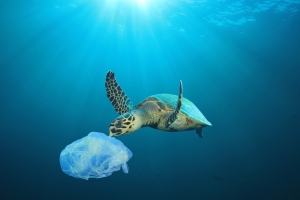OPPORTUNITY
Marine litter is a global issue, impacting seas and freshwater systems. Plastics constitute the majority of marine litter (OSPAR commission) and scientists predict that plastic waste in the ocean will amount to 250 million tons by 2025 (J. R. Jambeck et al., Science).
Plastics end up in the ocean for a variety of reasons, including poor waste management, illegal dumping, and littering. Most marine litter is created from land-based activities, while 20% is caused by marine activities like fishing and shipping. Coastal tourism (plastics bags, bottles, packaging), aquaculture and fisheries (discarding or losing fishing gear), shipping (ship-generated waste, plastic blasting in shipyards), cosmetics (use of microbeads), and fashion and textiles (synthetic fibres released during washing) all play a significant part in plastics entering the ocean.
The impact of plastic litter is huge. The United Nations estimated that every year plastic marine litter causes $13 billion of financial damage to marine ecosystems globally. Marine animals are often killed or injured after becoming entangled in derelict fishing nets or ingesting plastic. Marine litter imposes high clean-up costs on beaches and can have a profound impact on tourism. Increasingly, it is becoming a concern for human health; seafood can become contaminated with plastic particles and pollutants that are harmful to humans.
In spite of these negative impacts, there is very limited available data on marine litter concentrations. Innovative solutions are needed to prevent and solve the issues of marine litter and, especially, plastics in water bodies.
KEY FOCUS AREAS
- Monitoring and modelling plastic pollution in the ocean
- Monitoring and improving the logistics of plastic collection
- Tracking and tracing goods along a supply chain to reduce the likelihood of products or waste products ending up in water bodies
- Identifying illegal activities, such as waste dumping into oceans
- Improving waste management techniques
- Supporting the selection of new recycling infrastructure and improving recycling techniques
- Performing ex ante analysis of recycling missions impact
- Developing tele-education programmes tailored to developing economies: educate the local communities on marine litter and plastic impact to the environment
VALUE OF SPACE
Space technologies and data can play a significant part in preventing and solving problems relating to marine litter.

Satellite navigation (SATNAV)
- Satellite navigation (GNSS) provides accurate location information to track and trace goods being transported along the supply chain.
- It provides positioning information to support cleaning systems on the ground and at sea.
- It provides positioning information in support of unmanned aerial vehicles (UAVs) and automated cleaning systems. When equipped with optical and radar payloads UAVs can perform accurate analysis over specific areas of interest.
- Satellite – Automatic Identification Systems (SAT-AIS) can provide insight into the movement of seafaring vessels and can be used to prevent pollution caused by ships and improve pollution response.
Satellite communications (SATCOM)
- SATCOM enables communication when no terrestrial network is available e.g. in remote areas and at sea.
- It can also enhance communication network robustness and communication resilience by acting as a back-up when on-ground systems are down.
- SATCOM can enable data from offshore sensors (on vessels of other platforms) and crowdsourced data to be transmitted.
- It can provide communication in support of tele-education programmes covering rural locations.
- SATCOM provides Command and Control/payload communication links for UAVs or High Altitude Pseudo Satellites (HAPS) equipped with marine litter detection payloads.
Earth observation (SATEO)
- SatEO data can be used to measure and detect sea-borne plastic waste.
- Multi-spectral, hyper-spectral and high resolution optical satellites, as well as satellite radar data, can be used to pin-point potential areas of plastic accumulation, and monitor plastic “hotspots”.
- Data on ocean currents and other factors (sea state) can be collected and inputted into predictive models of marine litter accumulation.
WHAT WE OFFER
ESA Space Solutions will provide funding to successful teams looking to investigate the technical feasibility and economic viability of space-based applications in support of reducing environmental impact of plastics/marine litter, and define a roadmap for services implementation and demonstration.
The activities will be 100% funded up to €200K per activity.
WHAT ARE WE LOOKING FOR?
We look for teams that have identified an attractive market opportunity with real potential to engage customers. Motivation, business experience and domain expertise are all important features. We want to hear about your ideas that involve utilisation of either space technology or space data.
For this call, companies residing in the following Member States will be eligible to apply: Austria, Belgium, Czech Republic, Denmark, Estonia, Finland, France, Germany, Greece, Hungary, Ireland, Italy, Luxembourg, the Netherlands, Norway, Poland, Portugal, Romania, Spain, Sweden, Switzerland and the United Kingdom.
The applicable funding level of the individual prime - or subcontractors is subject to authorisation by the involved National Delegation(s). Therefore, bidding teams are requested to obtain a Letter of Authorisation from all the respective national delegations before submitting the Proposal.
ESA Tender Information
Responding to an open competitive Invitation to Tender (ITT) requires the submission of a Proposal. The Proposal will be evaluated according to ESA regulations and procedures.
The consequential evaluation of proposals results in a recommendation for a winning bid. In the case that several proposals of good quality targeting different and/or complementary aspects are submitted, the Agency reserves the right to place parallel contracts for each of the open competitive ITTs in coordination with the relevant national delegations.
For the fully detailed Proposal Guide on competitive ITTs click: Open Competition.
Registration as Bidder
The Prime and all subcontractors must register as potential bidders via esa-star, prior to downloading the official tender documents from EMITS (which will be available as soon as the ITT is open) and submitting their Proposal. The registration process needs to be started as soon as possible, as it will take time to complete.
Webinars
- 17/06/2020 - 16:15 CEST
- 24/06/2020 - 11:00 CEST



